Autobiographical sketch

My fascination for pottery began in Amsterdam in 1952 when a potter visited my elementary school with his wheel and the magical rising clay.
At the age of twelve I convinced my mother to let me work with a potter. My first teacher was Frida Koch. At her studio I enjoyed making big pots and decorating them. Years later I was admitted as a student at the Department of Ceramics of the Kunstnijverheidshool (later Rietveltacademie).
I had a strong drive and decided to do my first year in evening school so that in daytime I could start right away in class two, experimenting with glazes by following technical lessons in clay and glazes by Theo Dobbelmann who instructed several generations of ceramists. We learned to combine glazes from natural ingredients. A comprehensive technical archive with a whole array of color and variations in surface came into being.

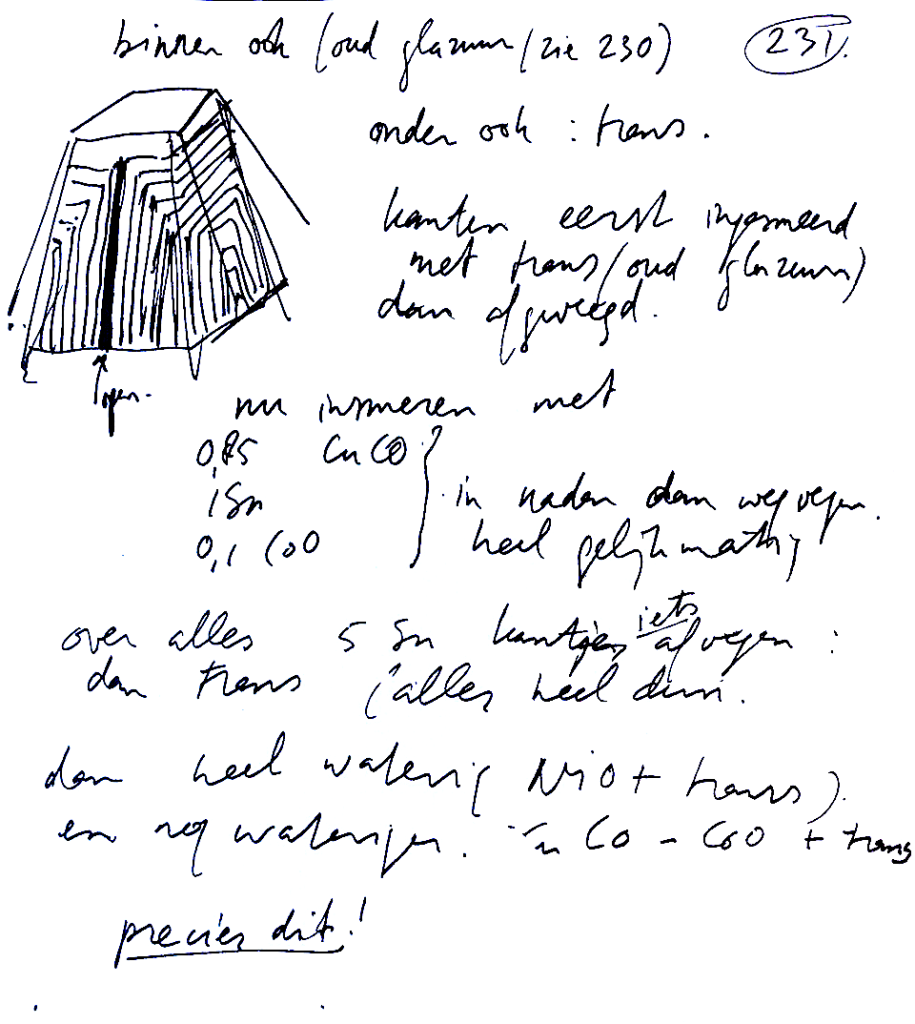
To give an impression of how I used that later: This is a page from one of the many glaze notebooks that I have kept over the years (the base glaze is here not mentioned, only the added pigments).
Professor Wim de Vries only allowed us to make functional forms. During some years the way I expressed myself in large objects irritated him. So I fired the objects in secret with help from the professor of the Department of Sculpture. When De Vries discovered that I continued with my own ideas, he gave me the choice to adapt to his way or leave school. We shook hands and that was the end of school.
I met the painter John Wortel. We lived together in Amsterdam, got married and had two beautiful sons. John and I inspired each other and exhibited jointly. We worked night and day, but it was difficult to make a living from our work. Flower shops were not even willing to pay as much as five gilders (2.25 Euros) for a unique ceramic piece. So I started to give pottery lessons to adults and patients in a mental health institution. In addition I set up a potters workshop in a clinic for alcoholics.
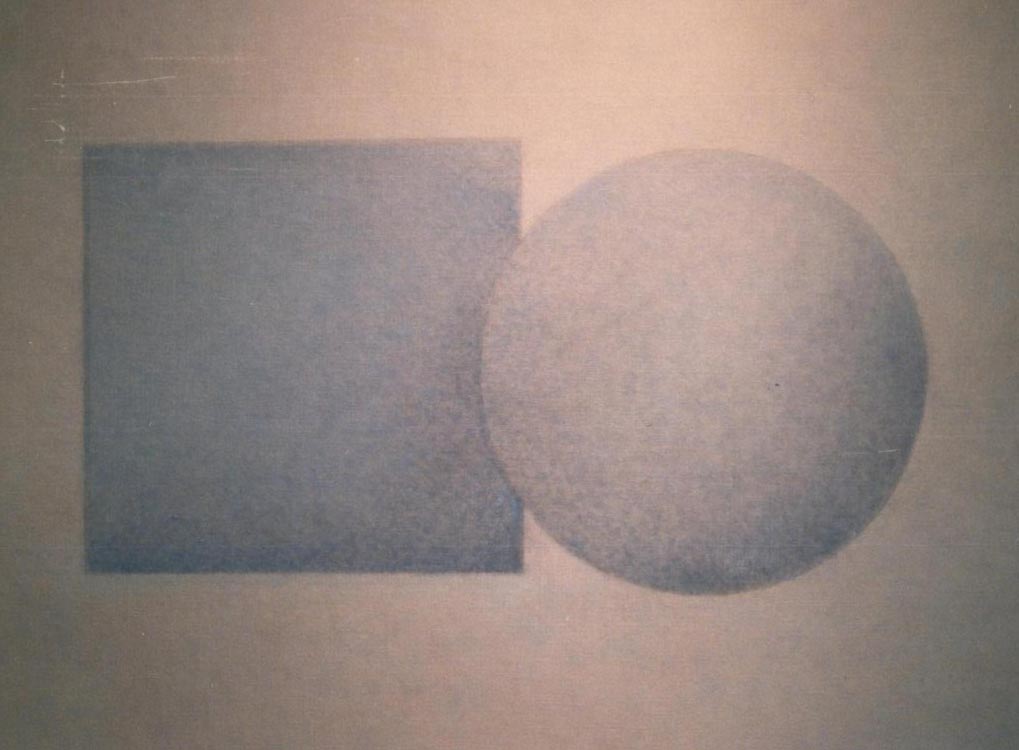
At a certain time my ceramic work was exhibited in the window of a shoe shop in the Leidsestraat in Amsterdam. It matched with the autumn colours of the shoe collection!

Benno Premsela, a leading authority in art, saw my work and became very enthusiastic. Next day he came to meet me at our house in the Korte Leidse dwarsstraat. His visit resulted in my first mayor sale to the Stedelijk Museum in Amsterdam. Premsela became my lifelong supporter. He never failed to show up at the openings of my exhibitions and in 1978 he opened my overview exhibition in Apeldoorn.
In the meantime we moved to Vianen, started to have house exhibitions and the museums purchased my work. In 1981 an international exhibition took place in the Sint Pieters Abdij in Gent. It was a homage to Carmen Dyonise. She invited potters from all over the world to be part of her exhibition and included me. Here I met Kees Hoogendam. This meeting resulted in joint projects.
In 1990 I started to live on my own and found a room in an old castle. At the same time I was invited to work as designer at the Royal Leerdam Cristal Studio. Working as a designer with glass blowers in factories became an alternative and new profession. After the rather solitary adventure of working in my ceramic studio and working with glass, there followed some years of more social engagement and solidarity with the people around me.
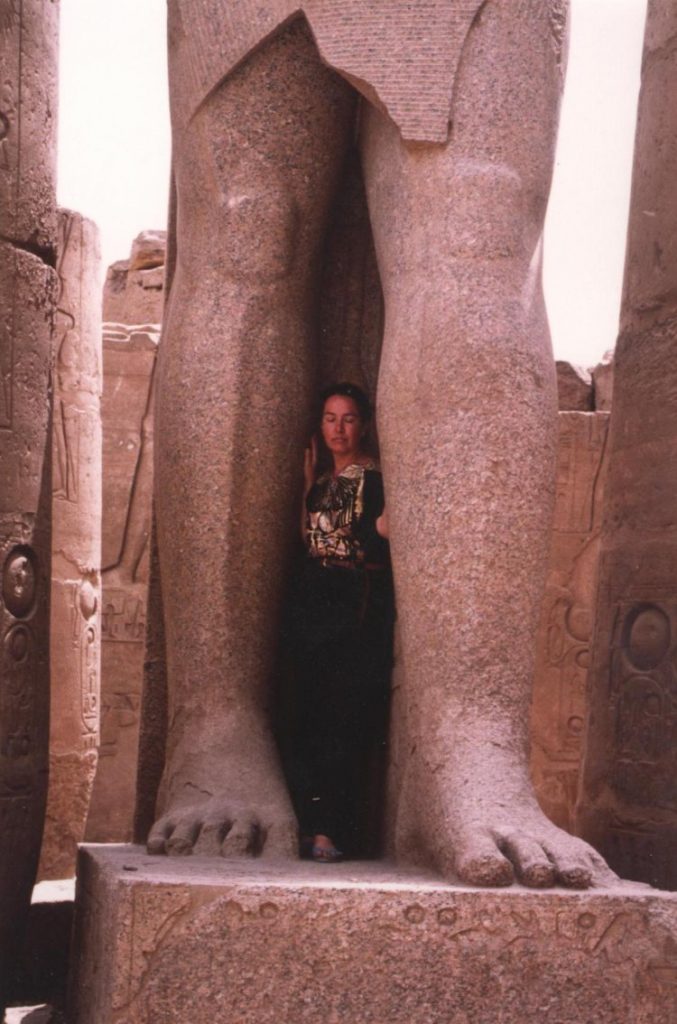
In 1993 I started to travel around the world. I visited Egypt, Nepal, India, Tibet and Hawaii, meeting other cultures. After a period of 12 years living at the castle I returned to Amsterdam where my roots are.
My work
Ceramics
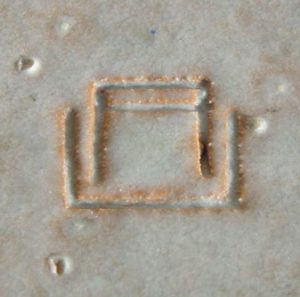
In sculpture the emphasis is generally placed on the relationship between the object and the space surrounding it. In my ceramics the emphasis is placed on the relationship between the object and its inner space. Mieke Spruit-Ledeboer cites me: ”For me ceramics is a skin that spans a mysterious inner space: emptiness” (M. Spruit-Ledeboer, Nederlandse Keramiek 1900-1975 , Assen, Van Gorcum, 1976).
More than to modern ceramic art, I’m attracted to the ancient, simple signs of mankind from all over the world as they are made in clay and baked in fire. In the world of modern ceramics the pot and vase forms seems to be out. Personally they constantly intrigue me. In that sense I feel connected with the English potter Hans Coper.
Throughout the years, integration of contradictions, expressed in form and shade, is a repeating theme in my work. I found ways to go from square to round, from dark to light, from inside to outside (see Introduction: first picture).
Instead of objects from earlier years which are standing heavily on the ground, some vases from the eighties almost seem to levitate like balloons (see Introduction: last picture).
In 1985 Kees Hoogendam and I made jointly man-sized high pots. His quick way of working and his technical skills helped me to overcome my slow process of creation due to my own tendency towards perfection. Where our opinions about material and form diverted, it became a challenge to find joint solutions. This process resulted in a large series of vases.
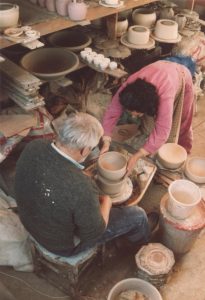
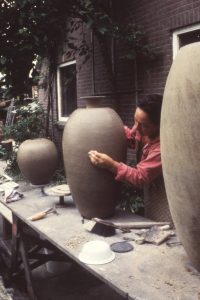
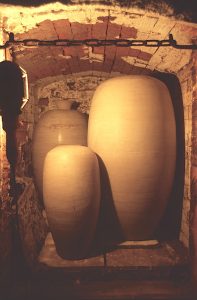
Hans Paalman director of the Stedelijk Museum of Schiedam, said in 1988, at the opening of the exhibition Survey of the cooperative works of Anne van der Waerden and Kees Hoogendam: ‘Starting from discussion and experiments, it has developed into cooperation in the real sense of the word.’
Glass
In the eighties for me working with glass, color, light and reflection became more and more attractive. The crystal glass objects were blown and formed by master blowers in Leerdam, Holland and in the Czech Republic. The design of the objects and vases is the result of a constant interaction between the blowers and me. In the Czech Republic – especially in former Bohemen – there was since centuries a rich glass tradition. Very famous is the red glass. The colour red is caused by the pigment gold. At my place I have some of these vases in ‘goldrubin’. They were blown in Studio Ajeto.

In the nineties the inspiration of massive egg shaped glass objects (see pictures in Introduction and work in Stock) came from stones that are found in India today and have been found there for the last 5000 years. The name of the naturally formed stone is the Lingam and it is worshipped as representing the Original Unity.